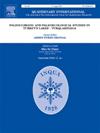Late glacial and Holocene vegetation history and climate oscillations – Preliminary pollen data from lake Boczne, NE Poland
IF 1.9
3区 地球科学
Q3 GEOGRAPHY, PHYSICAL
引用次数: 0
Abstract
This study was based on pollen data collected at Lake Boczne, NE Poland, and radiocarbon dating. Vegetation changes at the end of the last glacial period (Late Weichselian, Late Vistulian) and the during Holocene were documented. Due to specific location in a climate temperate transitional, this region is an interesting area for palaeoecological study. Therefore, the aim of the article was to indicate stadial-interstadial changes, short-term climatic fluctuations and the impact of human activity, which will allow for more detailed analyses of selected sections in the near future.
The Late Glacial record suggests the presence of sedimentary gaps and contamination of sediments that make interpretations of this period difficult. During the Early and Middle Holocene, the reconstructed changes in plant communities and pollen production indicate the presence of six potential short-lasting negative climate events, including the Early and Late Peboreal Oscillations, the 9.3 ka event rarely identified in records, and the most often described 8.2 ka event. The pollen record and radiocarbon dates indicate a hiatus lasting around 2200 years at the Middle/Late Holocene transition (between ca. 5000 and 3000 cal yr PB), which may have been caused by 2.8 ka global cooling or by human activity. After this gap, the Late Holocene record of vegetation changes illustrates human activity dynamic starting from the Roman Period. Our study is important because it is extremely rare to document vegetation changes for several intra-Holocene climatic oscillations in one profile, and studies at sensitive site allow the assessment of vegetation responses to different-scale climatic anomalies.
晚冰期和全新世植被史与气候振荡——波兰东北部Boczne湖的初步花粉资料
这项研究是基于在波兰东北部的Boczne湖收集的花粉数据和放射性碳定年法。记录了末次冰期末期(晚魏希塞利世、晚维斯世)和全新世期间的植被变化。由于该地区处于气候温带过渡时期,是一个有趣的古生态研究区域。因此,这篇文章的目的是指出间期变化、短期气候波动和人类活动的影响,以便在不久的将来对选定的部分进行更详细的分析。晚冰期记录表明,沉积间隙和沉积物污染的存在使得解释这一时期变得困难。在全新世早期和中期,植物群落和花粉生产的重建变化表明存在6个潜在的短期负面气候事件,包括早、晚Peboreal振荡,9.3 ka事件,记录中很少发现,以及最常描述的8.2 ka事件。花粉记录和放射性碳测年表明,在全新世中晚期(约5000 - 3000 cal yr PB)发生了2200年的中断,这可能是由2.8 ka全球变冷或人类活动造成的。在此间隙之后,晚全新世的植被变化记录说明了从罗马时期开始的人类活动动态。我们的研究是重要的,因为在一个剖面上记录几个全新世内气候振荡的植被变化是极其罕见的,而在敏感地点的研究可以评估植被对不同尺度气候异常的响应。
本文章由计算机程序翻译,如有差异,请以英文原文为准。
求助全文
约1分钟内获得全文
求助全文
来源期刊

Quaternary International
地学-地球科学综合
CiteScore
5.60
自引率
4.50%
发文量
336
审稿时长
3 months
期刊介绍:
Quaternary International is the official journal of the International Union for Quaternary Research. The objectives are to publish a high quality scientific journal under the auspices of the premier Quaternary association that reflects the interdisciplinary nature of INQUA and records recent advances in Quaternary science that appeal to a wide audience.
This series will encompass all the full spectrum of the physical and natural sciences that are commonly employed in solving Quaternary problems. The policy is to publish peer refereed collected research papers from symposia, workshops and meetings sponsored by INQUA. In addition, other organizations may request publication of their collected works pertaining to the Quaternary.
 求助内容:
求助内容: 应助结果提醒方式:
应助结果提醒方式:


